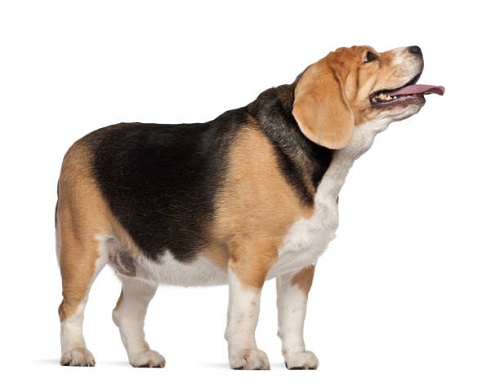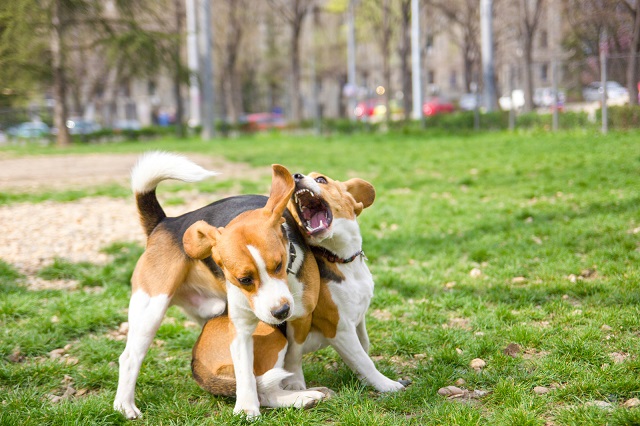Overweight and obesity is one of the main diseases affecting beagles. In this post, you will find a practical visual guide to detect if your beagle has weight problems and several very useful tips.
What is Obesity and Overweight in Dogs?
It is estimated that a dog is overweight when its body weight exceeds by more than 10% of its “ideal body weight”. Dog obesity is spoken of when the body weight exceeds the ideal by 20% or more. The explanation for overweight and obesity in dogs is simple: as in humans, when a dog consumes an excess of calories with respect to its needs, they accumulate in the form of fat. It is estimated that, in the United States, 52.6% of dogs are overweight and 17.6% suffer from dog obesity.
Causes of Overweight and Obesity in Dogs
Both overweight and obesity in dogs are growing problems. Lack of exercise, an inappropriate diet and the confusion of some owners who interpret food as a way to give affection to their dogs are the main causes of this problem.
Inappropriate Diet: Excess Calories or Nutrient Imbalance
An inappropriate diet, which contains an excess of calories, or giving your beagle an excessive amount of food is what causes the increase in increasing weight gain that leads to overweight or canine obesity. On the other hand, remember that hypercaloric prizes (the typical sweets for dogs) also favor overweight. Choose healthy prizes or choose to reward your dog with play instead of food.
Lack of Exercise
The sedentary life of some dogs favors the accumulation of fat. Remember that your beagle needs to exercise daily. Adapt it to your age and condition and maintain a constant routine of walks, playtimes, etc.
Diseases or Metabolism Problems
There are diseases that affect digestion and the way in which the dog’s body metabolizes nutrients. If you notice a considerable weight gain in your beagle without apparent cause, consult your veterinarian.
Castration
Research suggests that neutered dogs eat more and gain more weight than unneutered ones if they are allowed free access to food (in male dogs, this claim is not proven). However, we must not forget that, through diet and exercise, obesity is controllable.
Consequences of Obesity and Overweight
The excessive or abnormal accumulation of fat poses a risk to the health of any dog because it produces changes in its metabolism and favors the appearance of pathologies such as:
- Respiratory diseases
- Joint diseases
- Diabetes
- Pancreatitis
But the most serious consequence of overweight in dogs and dog obesity is the reduction in longevity that is associated with all these diseases.
How to Tell if a Dog is Overweight
To know if a dog is overweight or obese, there are two methods: Ideal weight tables reflect the ideal weight by breed. They are a good guide although not all breeds are reflected. In this VetWest link, you have an example of an ideal weight table. Body condition tables are tables that give a value of 1 to 5 depending on morphological characteristics of the dog, such as the silhouette, the shape of the waist and the palpation or not of the ribs.
How to Get a Beagle to Lose Weight
Before starting the process to get your beagle to lose weight, do not forget that the key to helping him is, mainly, perseverance. Get involved in the process from the first minute and do not forget that the health of your beagle depends on your care.
Changes in the Beagle Diet
The best diet to lose weight for a beagle is the one that your veterinarian tells you. No one knows your dog’s nutritional needs and medical history better than him. But you can also choose the specific food you need to maintain your dog’s ideal weight taking into account the different factors, such as age, that are indicated on the containers of specific food for weight loss.
In addition to changing the food for a specific one with the help of a veterinarian, you should completely eliminate your beagle’s bad eating habits, if any. Feeding changes that contribute to your dog losing weight are:
- Do not give food at odd hours.
- Stop giving the dog prizes for a while. It is not advisable to offer your beagle more than 10% in complementary feeding of the total kilocalories ingested daily.
- Do not give leftovers of homemade food.
- You will need to measure the daily ration needed by the dog every day.
- Prevent your beagle from eating food he finds on the street.
- Make the transition to the new diet in several days, following your vet’s recommendations.
Strict Feeding Schedules and Rations
While the beagle’s diet lasts, it will no longer be able to have the feeder full of food (even if it is specific food to lose weight) to feed whenever it is hungry, on the contrary, from now on you must control its intake by establishing very strict schedules to ensure that it does not eat more than is convenient.
If you are concerned that your beagle may have a feeling of hunger, you should know that dogs regulate that feeling in two ways: through the volume of their stomach when it is full and through blood glucose levels. We cannot offer the dog large amounts of food to satiate him, since the goal is to lose weight, but you can do something with blood glucose levels: you can feed him several times a day instead of concentrating all the food in 1 or 2 intakes since glucose levels rise after intake. The ideal is to distribute the food of the day in three portions and maintain the same schedules for each one, since in this way the dog will be calmer because he will know that in a few hours he will eat again and will not stress you so much.
Exercising
Do not increase the time of dog walks at once, do it gradually for the beagle to get used to the change. Remember that this is an overweight dog and is not at its physical best. Of course, exercise should be part of your beagle’s daily routine and increase in intensity as your physical strength and mood improve.
You can start with longer and longer walks, without forcing him to run, because if he exercises excessively, he could start to suffocate. It is recommended that every dog walk a minimum of 30 minutes a day, at a pace adapted to their physical condition. Playing a lot is also a good way to exercise your partner, as he will be losing weight while strengthening your bond of trust. In addition, exercising will help the dog lose his appetite.
After a few weeks, you can intensify the dog’s exercise by taking him to places where he has to overcome obstacles or you can even go for a bicycle ride together, first when jogging and if you see that he can exercise a little more, then he can run next to you while you go cycling. Remember to increase the level of exercise gradually so as not to wear your dog out.




